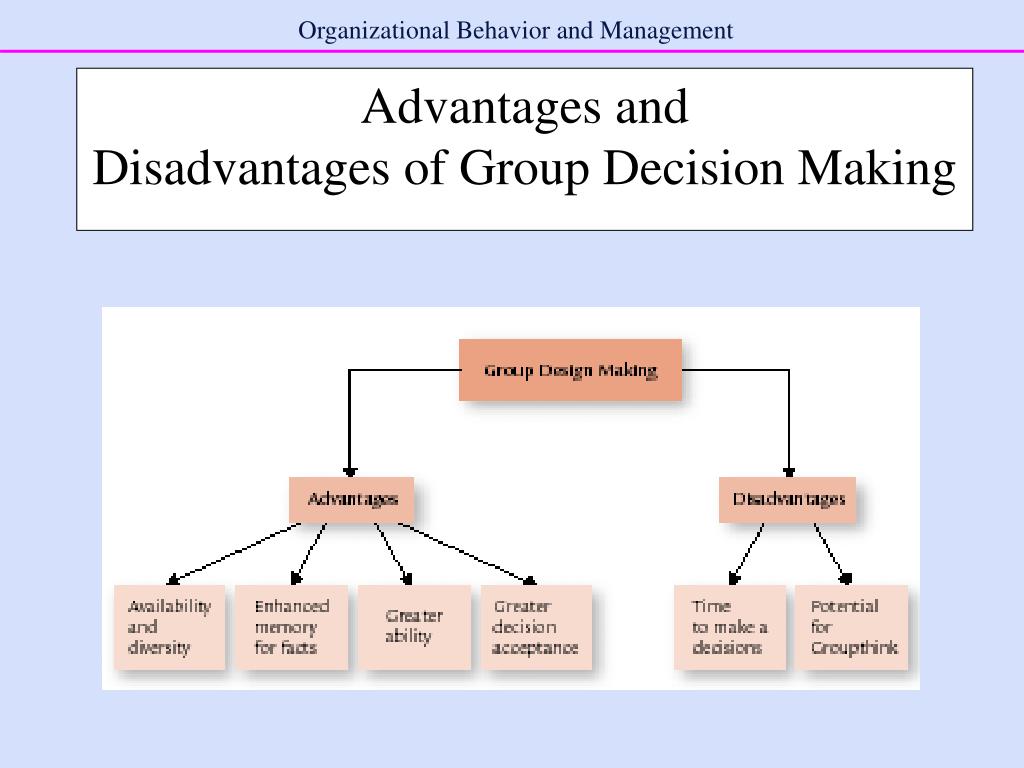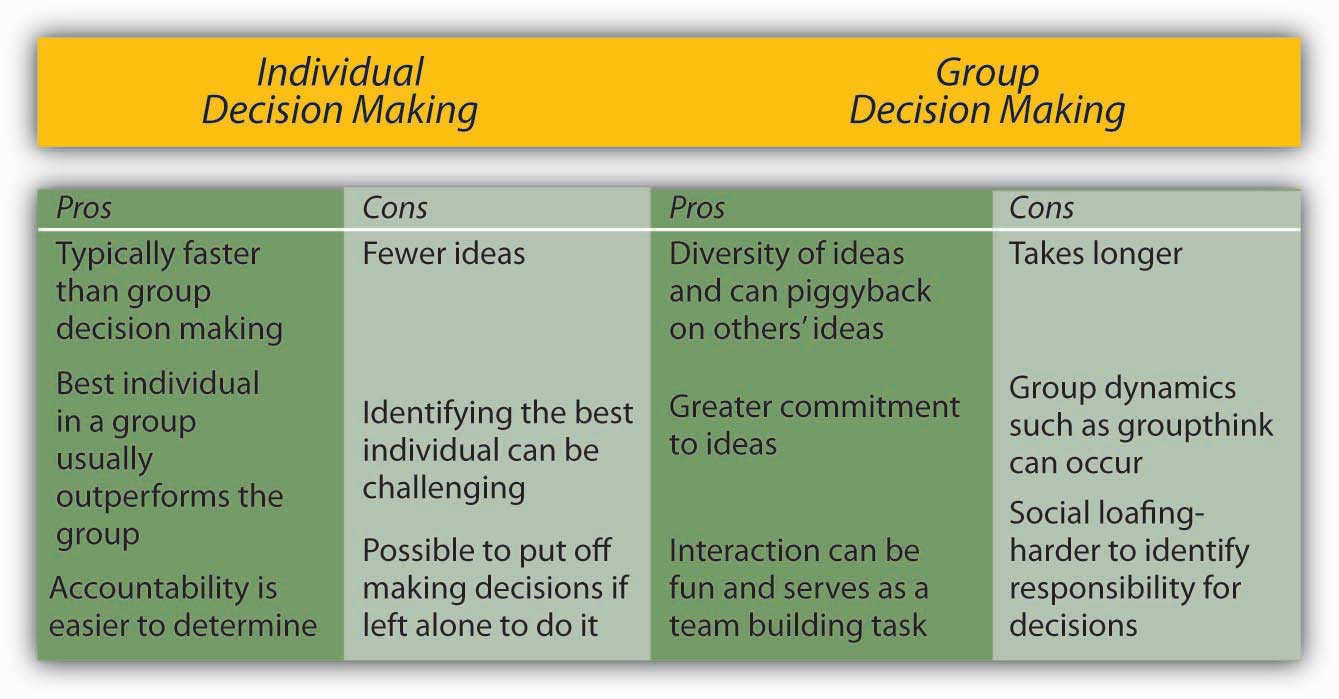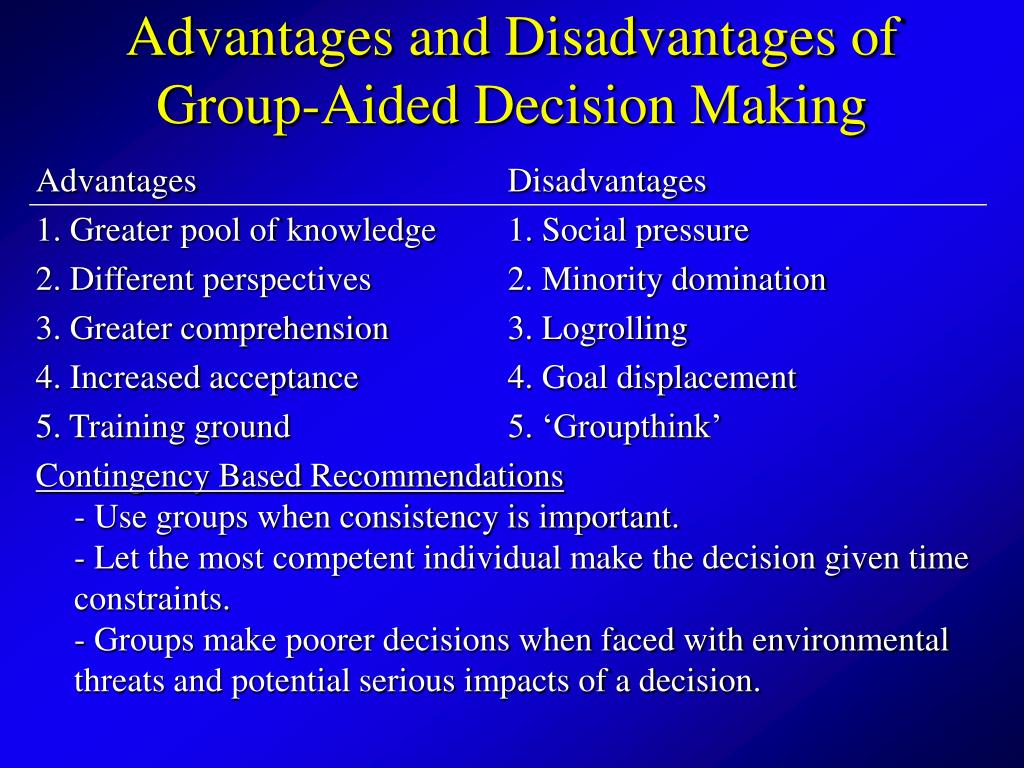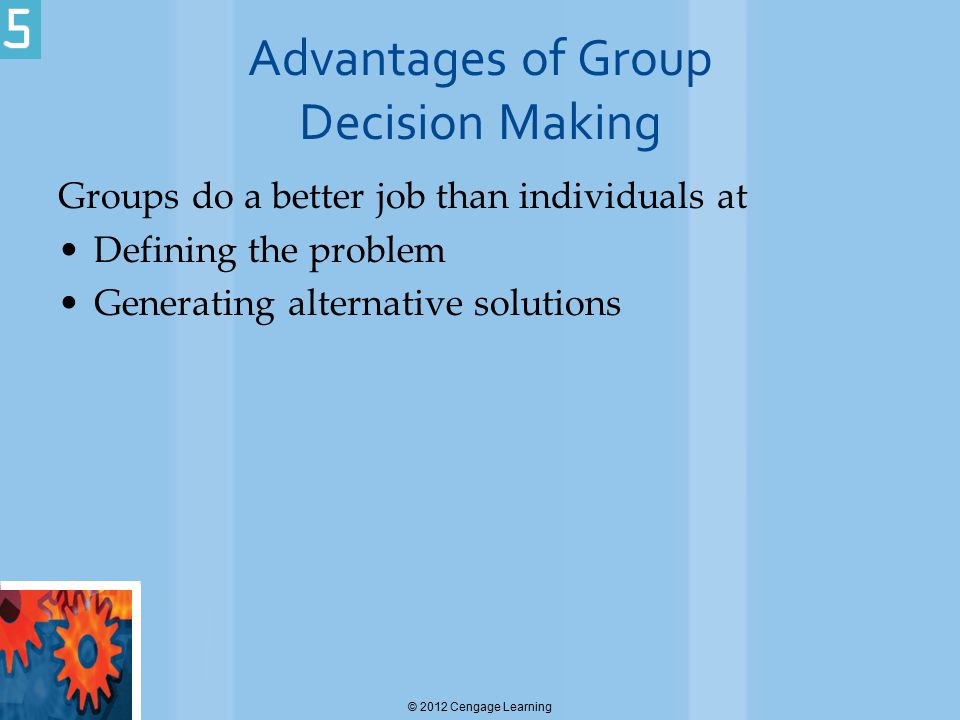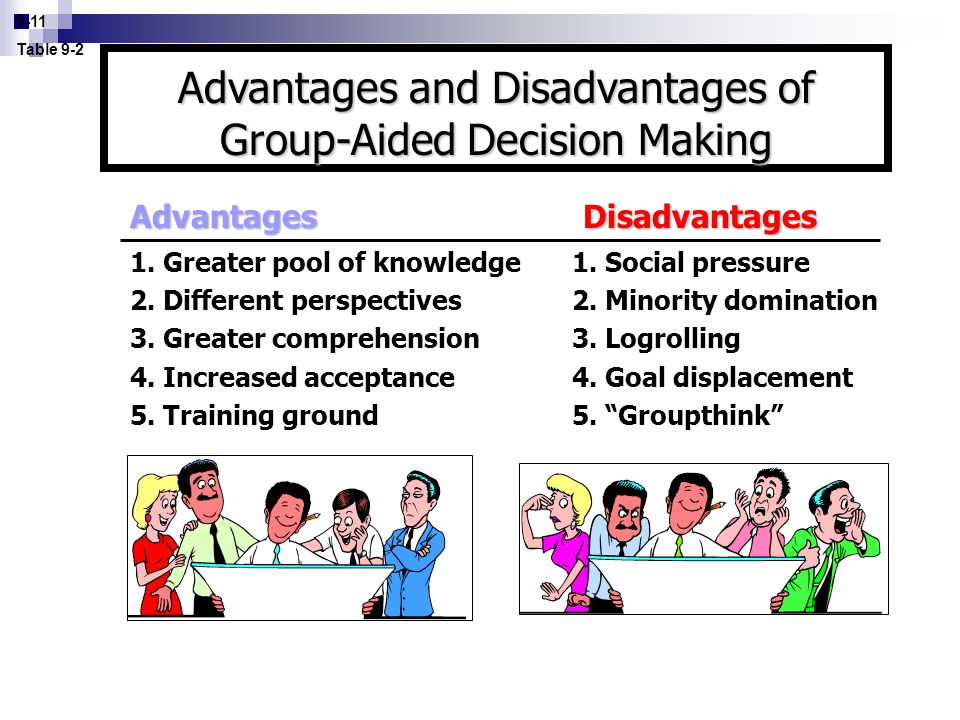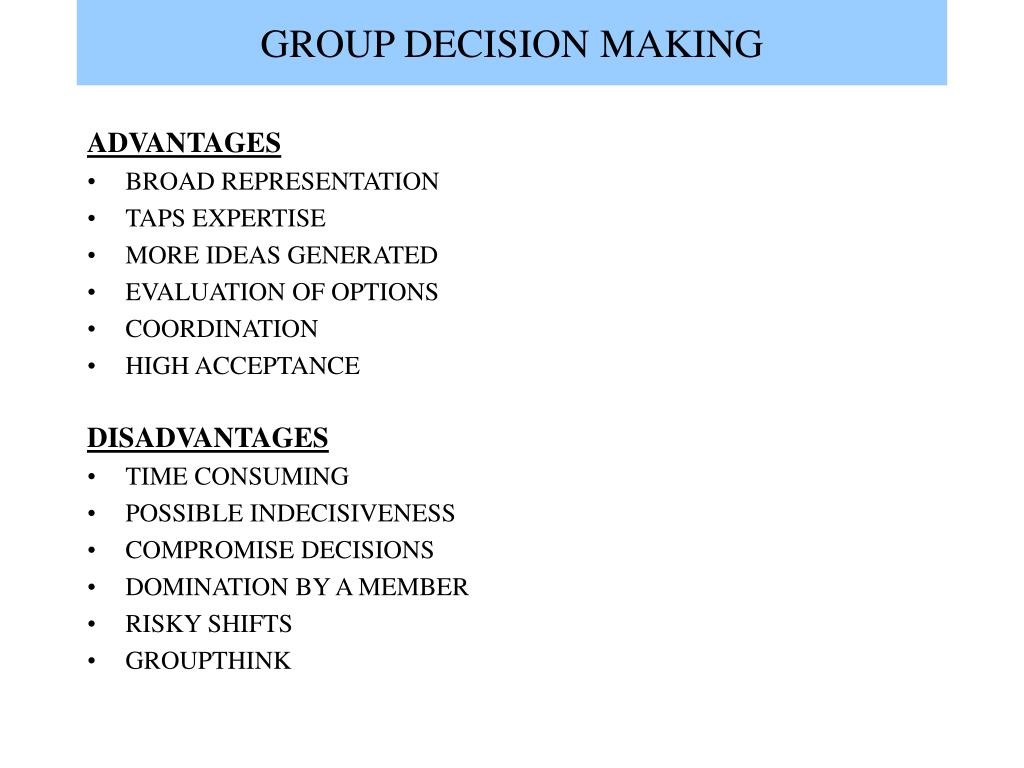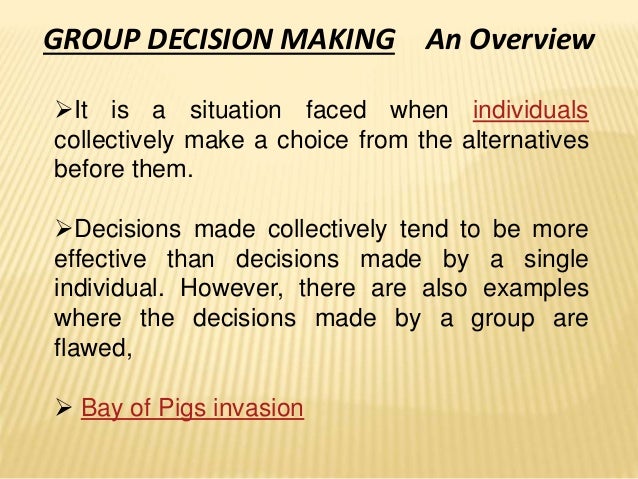Which Of The Following Is An Advantage Of Group Decision-making

The aroma of freshly brewed coffee hung heavy in the air, a silent promise of the brainstorming session to come. Around the large, polished table, colleagues trickled in, each clutching notepads and pens, their faces a mixture of anticipation and mild apprehension. The weight of the project felt palpable, a collective responsibility resting on their shoulders.
In today's collaborative environment, understanding the benefits of group decision-making is more critical than ever. While individual brilliance has its place, harnessing the collective intelligence of a team can lead to more innovative, well-rounded, and ultimately, successful outcomes. One significant advantage is the increased pool of knowledge and perspectives brought to the table, fostering a more comprehensive understanding of the problem at hand.
The Power of Collective Knowledge
Group decision-making, at its core, is about tapping into the diverse expertise and experiences of individuals. Each member brings a unique lens through which to view the issue, challenging assumptions and uncovering blind spots that a single decision-maker might overlook.
This collective knowledge base is particularly valuable when dealing with complex problems. A marketing team, for example, might include members with expertise in data analytics, creative design, and customer behavior. Pooling their knowledge helps them to make well-informed decisions.
Expanding the Horizon of Perspectives
Consider a scenario where a company is developing a new product. An individual decision-maker might be swayed by their own preferences or biases, potentially leading to a product that appeals only to a narrow segment of the market.
However, a group discussion involving representatives from different departments – engineering, sales, marketing, and customer service – can broaden the perspective. It can uncover potential issues and lead to a more inclusive and appealing product design.
"The best way to have a good idea is to have a lot of ideas," said Linus Pauling, emphasizing the importance of diverse perspectives in innovation.
Mitigating Bias and Groupthink
Individual decision-making is often susceptible to cognitive biases, unconscious mental shortcuts that can distort our judgment. These biases can lead to flawed decisions, especially in high-pressure situations.
Group decision-making, when conducted effectively, can help mitigate these biases. By encouraging open dialogue and critical thinking, teams can challenge each other's assumptions and identify potential flaws in reasoning.
However, it's essential to be aware of "groupthink," a phenomenon where the desire for harmony within the group overrides critical evaluation of alternative viewpoints. This can lead to poor decisions, even when a wealth of knowledge is present.
Encouraging Constructive Conflict
To avoid groupthink, it's crucial to foster a culture of constructive conflict. Team members should feel comfortable expressing dissenting opinions and challenging the status quo.
This requires strong leadership and a commitment to creating a safe space for debate. Strategies such as assigning a "devil's advocate" or using anonymous feedback mechanisms can help to surface hidden concerns and prevent premature consensus.
Dr. Jane Goodall once stated, "The greatest danger to our future is apathy." Apathy in team decision making can come from unwillingness to challenge ideas and create the best solution.
Enhanced Creativity and Innovation
The synergistic effect of group decision-making can spark creativity and innovation. When individuals with different backgrounds and perspectives come together, they can build upon each other's ideas, leading to novel solutions that might not have been possible otherwise.
Brainstorming sessions, design thinking workshops, and other collaborative activities can facilitate this process. These methods encourage participants to think outside the box and explore unconventional approaches.
According to a study by the Harvard Business Review, companies that embrace diverse teams are more likely to generate innovative ideas and achieve superior financial performance.
Building Buy-In and Commitment
Involving team members in the decision-making process fosters a sense of ownership and commitment. When individuals feel that their voices have been heard and their opinions valued, they are more likely to support the final decision and work diligently towards its implementation.
This increased buy-in can lead to improved morale, reduced resistance to change, and enhanced overall productivity.
As Peter Drucker famously stated, "The best way to predict the future is to create it." By empowering employees to participate in decision-making, organizations can cultivate a culture of ownership and create a shared vision for the future.
Challenges and Mitigation Strategies
While group decision-making offers numerous advantages, it's not without its challenges. These challenges include time consumption, potential for conflict, and the risk of domination by certain individuals.
To mitigate these challenges, it's essential to establish clear goals, ground rules, and decision-making processes. Appointing a facilitator can help to keep discussions on track, manage conflict, and ensure that everyone has an opportunity to contribute.
Effective communication is crucial for successful group decision-making. Team members should be encouraged to listen actively, express their ideas clearly, and provide constructive feedback. Use tools like project management software to stay on track.
Leveraging Technology for Collaboration
In today's digital age, technology plays a crucial role in facilitating group decision-making. Collaboration platforms, video conferencing tools, and online survey platforms can enable teams to work together seamlessly, regardless of their physical location.
These technologies can also help to document discussions, track progress, and ensure that decisions are transparent and accountable. Project management platforms can provide a central hub for communication, task management, and file sharing, streamlining the decision-making process.
"The key is not the will to win… everybody has that. It is the will to prepare to win that is important," said Paul Bear Bryant. Modern technology can help organizations prepare effectively for a collaborative and productive decision-making process.
Conclusion
As the meeting adjourned, a sense of accomplishment filled the room. The initial apprehension had dissipated, replaced by a shared understanding and a renewed commitment to the project. The diverse perspectives, the constructive debates, and the collective wisdom had yielded a decision that felt both robust and innovative.
In conclusion, the increased pool of knowledge and perspectives is a significant advantage of group decision-making. By harnessing the collective intelligence of a team, organizations can mitigate bias, foster creativity, build buy-in, and ultimately, make better decisions.
While challenges exist, these can be effectively addressed through careful planning, strong leadership, and a commitment to fostering a collaborative and inclusive environment. In an era of increasing complexity and rapid change, the power of group decision-making is more important than ever.
